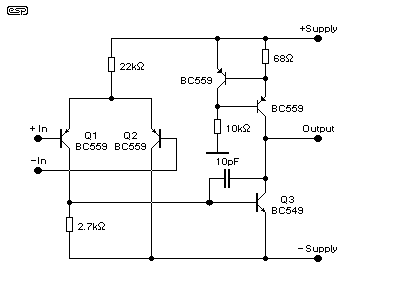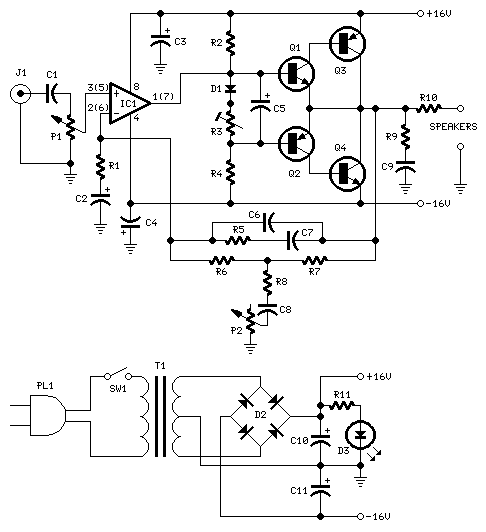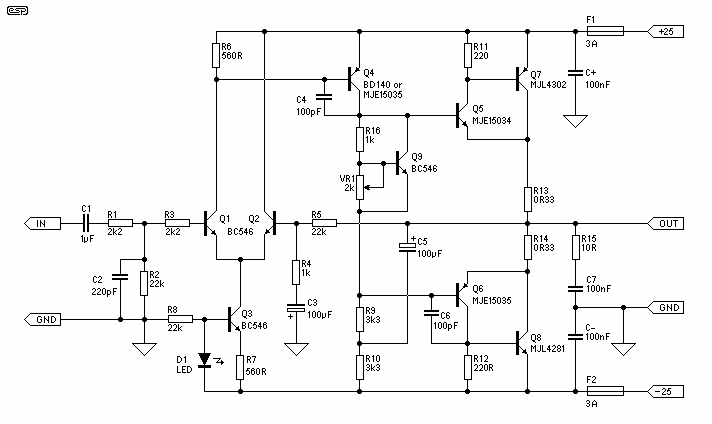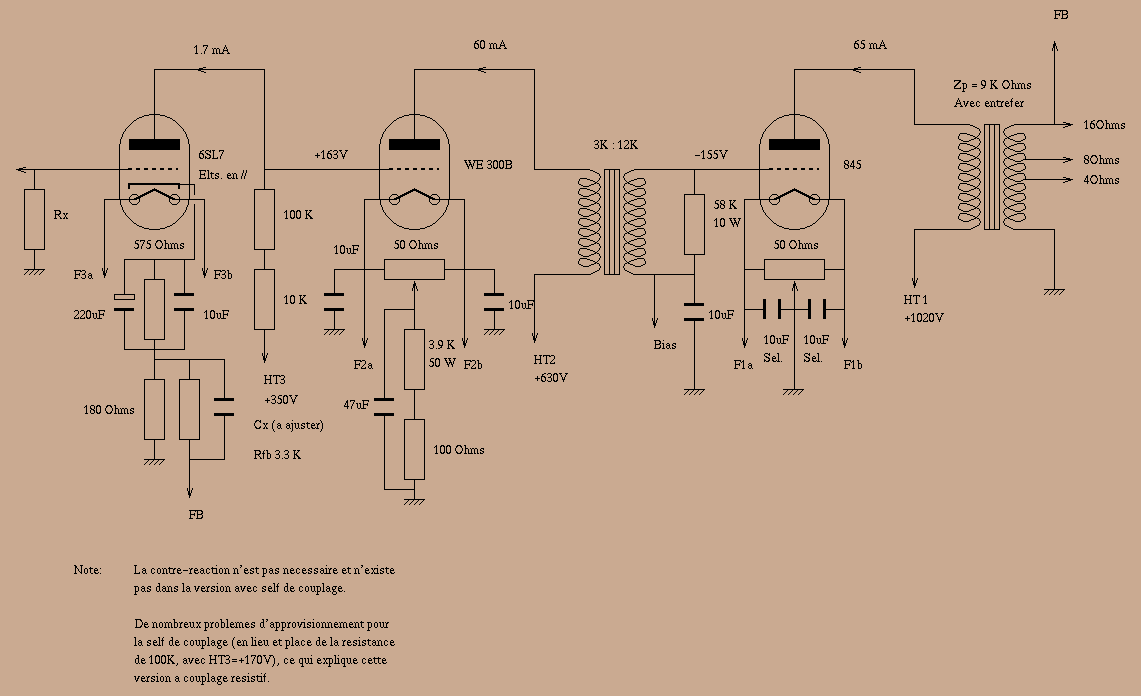
Five-transistor amplifier
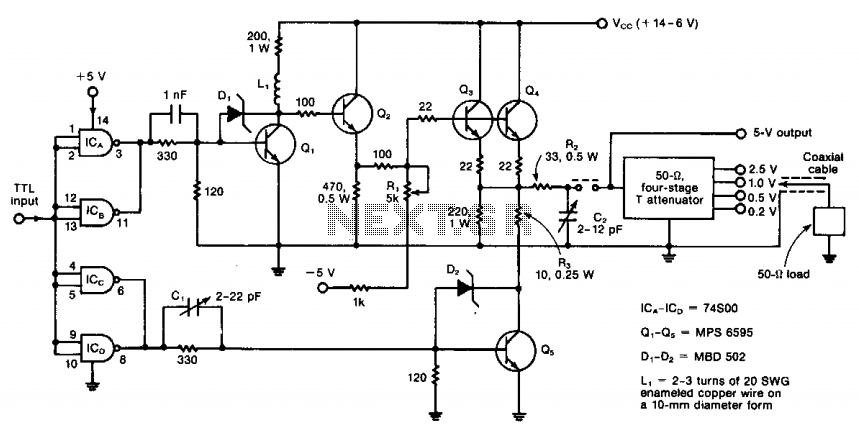
The circuit operates from DC to 50 MHz and is capable of delivering pulses as short as 10 ns. It is driven by a TTL signal through a 740S00 quad Schottky NAND gate, with input connections made via ICA and ICD. Transistor Q1, configured as a common-emitter amplifier, drives transistor Q2, which functions as a simple emitter follower. Transistors Q3 and Q4 are wired in parallel and also act as an emitter follower to drive the output. When both Q3 and Q4 are turned off, transistor Q5 serves as a low-impedance sink. Schottky diodes D1 and D2 prevent Q1 and Q5 from entering saturation. A potentiometer R1 is used to optimize the fall time of the output pulse. Inductor L1, functioning as a peaking coil, should be adjusted to achieve a rise time within a permissible 5% overshoot. Additionally, capacitor C1 can be varied to control pre-shooting. Further shaping of the output pulse is achieved with capacitor C2. Resistors R2 and R3 maintain a proper 50-ohm impedance at the amplifier's output during both active and inactive pulse states.
The circuit is designed to operate efficiently across a frequency range from DC to 50 MHz, making it suitable for high-speed applications. The use of a TTL signal to drive the circuit ensures compatibility with digital logic levels, allowing for straightforward integration into existing systems. The 740S00 quad Schottky NAND gate provides fast switching characteristics due to its Schottky diode technology, which minimizes propagation delay.
Transistor Q1, as a common-emitter amplifier, amplifies the input signal, providing a necessary gain before driving the subsequent stages. The configuration of Q2 as an emitter follower allows for impedance matching, ensuring that the signal is transferred effectively to the output stage without significant loss.
The parallel configuration of transistors Q3 and Q4 enhances the output drive capability, allowing for a stronger output signal while maintaining low output impedance. The role of transistor Q5 as a low-impedance sink is critical in maintaining signal integrity, especially during transitions when Q3 and Q4 are turned off.
The inclusion of Schottky diodes D1 and D2 is essential for protecting the circuit from saturation, which could lead to distortion or unwanted signal behavior. The adjustment of potentiometer R1 allows for fine-tuning of the output pulse characteristics, particularly its fall time, which is crucial for high-speed signal applications.
Inductor L1 serves as a peaking coil, and its adjustment is vital for optimizing the rise time of the output pulse. This ensures that the signal remains within the desired overshoot limits, which is important for preventing signal integrity issues in high-frequency applications. The ability to vary capacitor C1 provides additional control over pre-shooting, allowing for further refinement of the output signal.
Capacitor C2 plays a significant role in shaping the output pulse, allowing for additional fine-tuning of the signal waveform. The resistors R2 and R3 are strategically placed to ensure a consistent 50-ohm impedance at the amplifier's output, which is crucial for minimizing reflections and maximizing power transfer in RF applications. This impedance matching is particularly important in high-frequency circuits to maintain signal fidelity and prevent degradation of the output pulse quality.The circuit works from dc to 50 MHz and will deliver pulses as short as 10 ns. It is driven by a TTL signal through a 740S00 quad Schottky NAND gate, ICA through ICD. Transistor Ql, wired as a common-emitter amplifier, drives transistor Q2, a simple emitter follower. Transistors Q3 and Q4, wired in parallel, also form an emitter follower and drive the output. When Q3 and Q4 are both turned off, transistor Q5 works as a low-impedance sink. Schottky diodes Dl and D2 prevent Ql and Q5 from becoming saturated. To adjust the circuit, potentiometer Rl is set to optimize the output pulse's fall time. Inductor LI, a peaking coil, should be adjusted to improve the rise time to within a permissible 5% overshoot. Likewise, capacitor CI can be varied to control pre-shooting. Further output pulse shaping is accomplished with the help of capacitor C2. Resistors R2 and R3 ensure a proper 50-ohm impedance at the amplifier's output when the pulse is on or off, respectively.
The circuit is designed to operate efficiently across a frequency range from DC to 50 MHz, making it suitable for high-speed applications. The use of a TTL signal to drive the circuit ensures compatibility with digital logic levels, allowing for straightforward integration into existing systems. The 740S00 quad Schottky NAND gate provides fast switching characteristics due to its Schottky diode technology, which minimizes propagation delay.
Transistor Q1, as a common-emitter amplifier, amplifies the input signal, providing a necessary gain before driving the subsequent stages. The configuration of Q2 as an emitter follower allows for impedance matching, ensuring that the signal is transferred effectively to the output stage without significant loss.
The parallel configuration of transistors Q3 and Q4 enhances the output drive capability, allowing for a stronger output signal while maintaining low output impedance. The role of transistor Q5 as a low-impedance sink is critical in maintaining signal integrity, especially during transitions when Q3 and Q4 are turned off.
The inclusion of Schottky diodes D1 and D2 is essential for protecting the circuit from saturation, which could lead to distortion or unwanted signal behavior. The adjustment of potentiometer R1 allows for fine-tuning of the output pulse characteristics, particularly its fall time, which is crucial for high-speed signal applications.
Inductor L1 serves as a peaking coil, and its adjustment is vital for optimizing the rise time of the output pulse. This ensures that the signal remains within the desired overshoot limits, which is important for preventing signal integrity issues in high-frequency applications. The ability to vary capacitor C1 provides additional control over pre-shooting, allowing for further refinement of the output signal.
Capacitor C2 plays a significant role in shaping the output pulse, allowing for additional fine-tuning of the signal waveform. The resistors R2 and R3 are strategically placed to ensure a consistent 50-ohm impedance at the amplifier's output, which is crucial for minimizing reflections and maximizing power transfer in RF applications. This impedance matching is particularly important in high-frequency circuits to maintain signal fidelity and prevent degradation of the output pulse quality.The circuit works from dc to 50 MHz and will deliver pulses as short as 10 ns. It is driven by a TTL signal through a 740S00 quad Schottky NAND gate, ICA through ICD. Transistor Ql, wired as a common-emitter amplifier, drives transistor Q2, a simple emitter follower. Transistors Q3 and Q4, wired in parallel, also form an emitter follower and drive the output. When Q3 and Q4 are both turned off, transistor Q5 works as a low-impedance sink. Schottky diodes Dl and D2 prevent Ql and Q5 from becoming saturated. To adjust the circuit, potentiometer Rl is set to optimize the output pulse's fall time. Inductor LI, a peaking coil, should be adjusted to improve the rise time to within a permissible 5% overshoot. Likewise, capacitor CI can be varied to control pre-shooting. Further output pulse shaping is accomplished with the help of capacitor C2. Resistors R2 and R3 ensure a proper 50-ohm impedance at the amplifier's output when the pulse is on or off, respectively.
